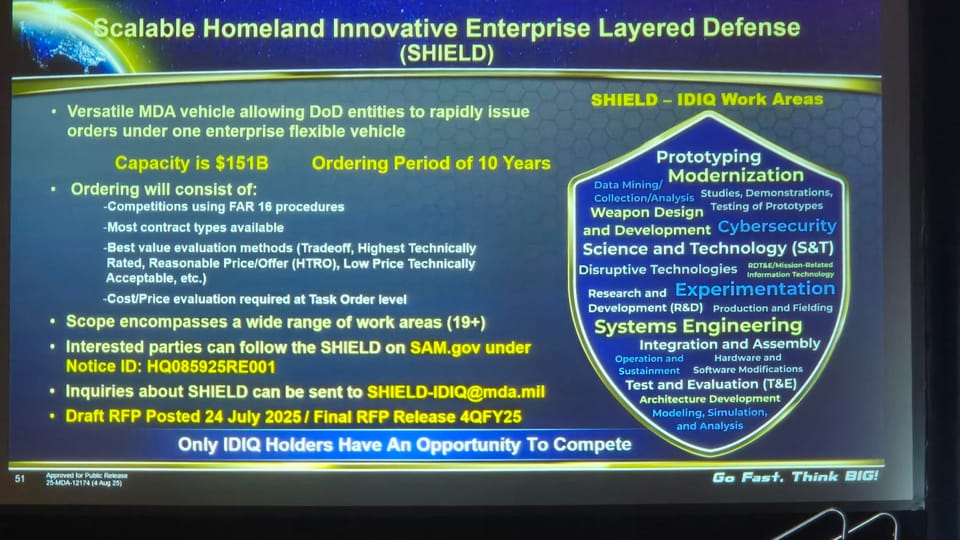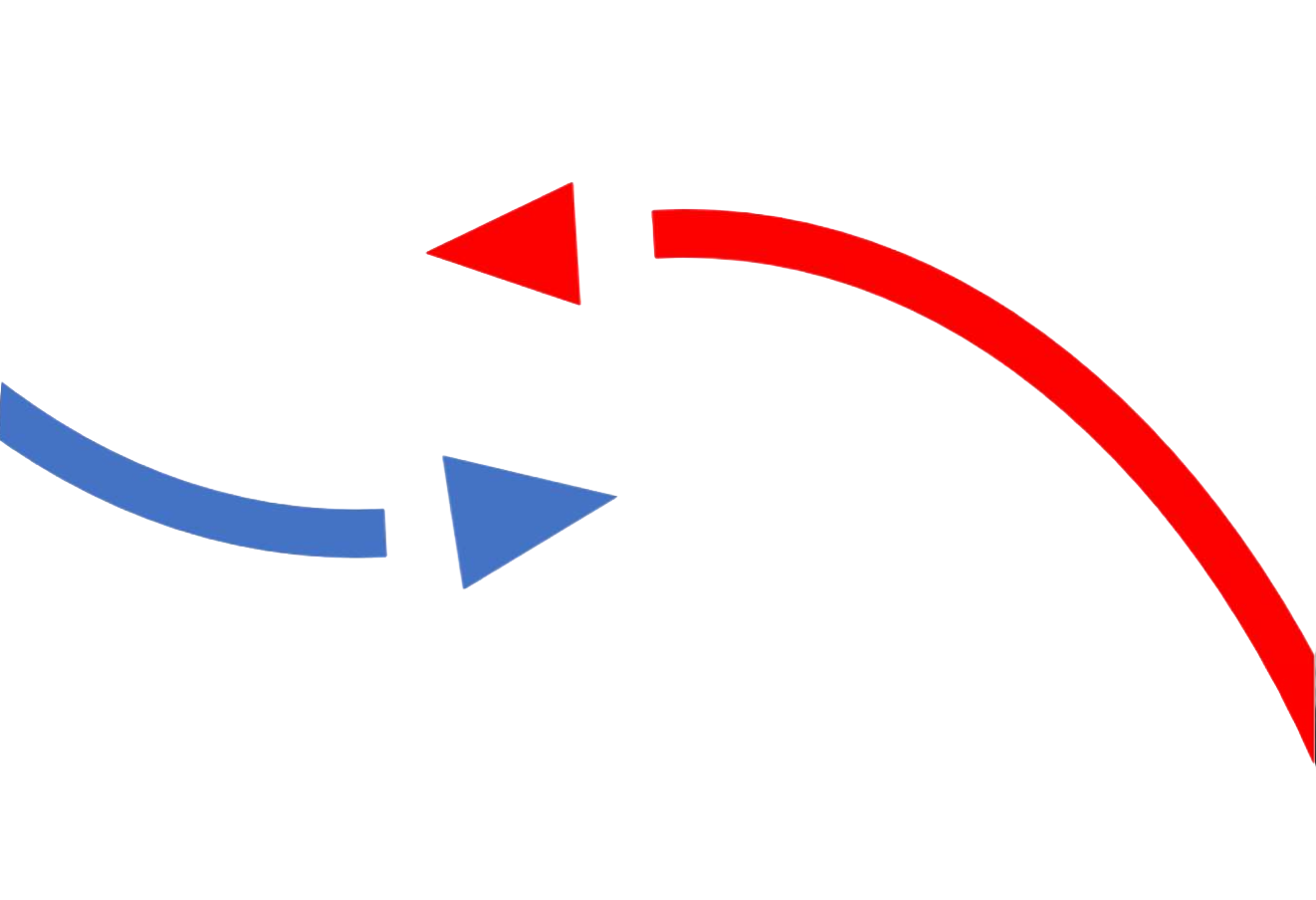Save your Golden Dome

This could have been a Zoom call.
If you missed the Golden Dome conference in Alabama, you didn't miss much. Here is everything you didn't really miss.
GDID Summary:
🎯 Mission & mandate. Leadership framed Golden Dome for America as a presidentially‑directed push to field homeland missile‑defense capabilities “at speed,” emphasizing a real, global, multi‑vector threat and a need to partner widely beyond traditional primes.
🧱 Five‑layer architecture (what they’re building). Space layer (warning/sensing/defense) ➝ Upper layer (ICBM‑class expansion), Under layer (ballistic + hypersonic in atmosphere), Limited‑Area Defense (cruise & air‑breathing threats), and a Domain Awareness/C2 layer that stitches it all together.
🛰️ Space‑Based Interceptors (SBI) are back—operationally minded. Space Force and MDA are standing up an integrated program office; they want a demonstration‑first, cost‑disciplined approach that exploits cheaper launch/proliferation trends. SBI is one layer in the stack, with a common ground/fire‑control backbone and an eye toward both boost and early post‑boost shots.
🧭 Domain Awareness = the keystone. They want a common operating picture across strategic/operational/tactical echelons; coordinated offense/defense/cyber; a low‑latency data mesh to cue “any sensor → best shooter,” and dynamic plans that manage by exception (kill/no‑kill, re‑engage). CTBMC is today’s core, but they need more automation, fusion, and speed.
🧩 Joint, integrated fire control—already prototyping. Goal: a joint network where any shooter can fire off any sensor. They cited a Patriot shot using Marine G/ATOR tracks as an early exemplar and mentioned a “Joint Track Management Capability” bridge.
🛡️ Upper layer—expand & harden. Upgrade terrestrial long‑range radars (UEWRs, LRDR), deploy NGI at scale with potential CONUS sites, and add a Southeast Radar and transportable theater‑ground radars. RFIs are out to industry.
🏃 Under layer—flexible, mobile, and automated. Aim is wide‑area defense against low‑trajectory ballistic and hypersonic threats, tightly integrated with the upper layer (deconflicted fires). They issued an RFI for a common launcher, want virtualized capability and minimal manning to enable rapid placement/relocation.
🪖 Limited‑Area Defense (Army MCP concept). Scalable “Minimum Capability Package” = IBCS EOC + LTAMDS + Sentinel A4 + ALPS + Patriot + IFPC, linked via integrated fire control for 360° defense; number of MCPs scales to the city/terrain. Strong emphasis on counter‑sUAS for self‑protection.
🤖 Remotely‑operated & AI‑enabled fire control (Army tech asks). Push more ops from radars to the EOC; containerized, low‑signature units; automated emplacement/reload; resilient multi‑path comms; UPS‑like power failover; net‑centric init/patching; status/maintenance “as a service.” For AI: train CCTDI models, optimize shot doctrine & BDA in real time, and keep humans on final calls in ambiguous civil‑mil airspace.
🧪 Test at pace = cultural shift. Testing becomes the center of gravity: agile, affordable, efficient. Drive analysis latency from months → minutes via instrumentation & digital tools; pursue monthly flight tests (at least quarterly subsystem), plus big multi‑threat capstones. Example of new risk posture: Dec 10, 2024 Guam event (C‑17‑dropped target, SM‑3 IIA intercept) was pulled left by risk‑accepting planning.
⏱️ Cadence & affordability levers. More affordable targets (orders‑of‑magnitude cheaper), integrated test baselines with other Services, and lab virtualization to pull learning left.
🧮 Fire‑control doctrine & load management. Centralized control / decentralized execution—and layered thinning so terminal defenses aren’t saturated. The network must report kill/no‑kill fast to prevent wasteful over‑engagement.
📡 C2 vertical & horizontal integration. Connect missile defense, air defense, and space at strategic/operational/tactical levels; push the right data (not all the data) to prevent network collapse.
🧾 Acquisition pathway (new umbrella). MDA previewed a “Multiple Authority Announcement” rebranded as NOBLE — Nimble Options for Noble Effects: a standing vehicle (through 2030) spanning BAAs, CSOs, OTAs, procurement‑for‑experimentation, grants, and CRADAs (now explicitly authorized for MDA) to chase disruptive tech across 8 focus areas. Expect solicitations via SAM.gov and an “Engage Partner With Us” portal.
🔐 Cyber & resilience baked in. Assume the system itself is under attack; secure the C2/data mesh; design for graceful degradation and rapid reconstitution; status telemetry must drive predictive maintenance.
🔗 So what for industry. Bring automation, AI/ML, secure comms/power, data‑fabric tech, fast instrumentation, affordable targets, and open architectures—and be ready to move fast under non‑traditional contracting.
🚀 Space Domain Awareness (SDA) Mentions
No dedicated SDA brief.
The event did not carve out a separate block explicitly labeled “Space Domain Awareness.” It was not described in the same way the other layers (Upper, Under, Limited-Area, Domain Awareness) were.
Indirect tie-ins:
The space layer of the five-layer architecture was described in terms of space-based interceptors (SBI), sensing, and warning — but the conversation stayed tactical (missile tracking, boost/post-boost intercept windows) rather than broad SDA (tracking debris, monitoring non-missile objects, characterizing adversary space behavior).
The Domain Awareness section discussed “any sensor → best shooter,” integrated C2, and a common operating picture. That naturally includes space sensors, but the transcript keeps the scope to missile defense mission sets, not full-spectrum SDA.
SBI integration implied use of space-based sensors and ground fusion nodes that could serve SDA purposes, but no one said “space domain awareness” or described the broader SSA/SDA enterprise (e.g., 18th Space Defense Squadron, cislunar tracking, debris catalogs).
Closest language to SDA:
References to global sensing and overhead persistent infrared (OPIR) for missile warning, as well as integration of space-based interceptors into the layered defense.
Need for a low-latency data mesh to fuse sensor data from “space, air, land, and sea” into actionable fire-control quality tracks.
Emphasis on resilient space-based capability to “see the threat sooner” and “reduce decision time,” which overlaps with SDA in a missile-defense context.
🧐 Analyst Bottom Line
SDA was implied but not a focal point.
They clearly depend on space-based sensors for the missile defense mission, but they did not address the broader SDA mission (tracking all space objects, space traffic management, counterspace threat monitoring).
In this event, “space” = sensor layer + interceptor layer inside the missile defense architecture — not the full SDA enterprise you’d hear from Space Command or USSF Delta 2.


